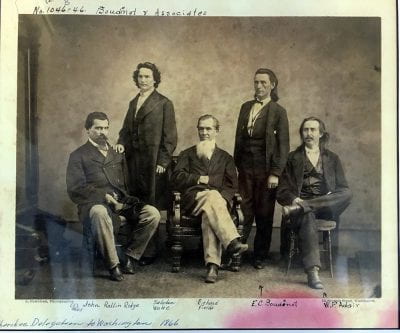
William Quesenbury, Fayetteville Female Seminary, ca. 1852, Courtesy of the Butler Center for Arkansas Studies, Central Arkansas Library System
Author Bio: Curtis Worley is a senior at the University of Arkansas, completing his B.A. in May 2021 with a Major in Cultural Anthropology and minor in history. His study interests lie in military history, development of religions, and Dark Age degradation of civilization.
The story of education here in Fayetteville begins with disruption! The forced migration of Native Americans that has become known as the Trail of Tears unleased a series of events that ultimately established the town as the center of education in the state. Educator and missionary Sophia Sawyer arrived in 1839 after the killing of her employer, Cherokee leader John Ridge. Ridge was killed during a period of factional violence that resulted from the chaos surrounding the displacement of the Cherokee. Sawyer accompanied Ridge’s widow, Sarah, and her children as she fled Indian Territory to avoid further violence. Cephas Washburn, another noted educator, also departed Indian Territory for Fayetteville at the same time. Together with their Cherokee pupils, Washburn and Sawyer laid the groundwork for Fayetteville’s commitment to education.
When Sawyers’ party arrived in Fayetteville it was a small town of 400, incorporated only 10 years earlier. While the Ridge family planted roots in their new home, Sawyers’ first mission was to bring a new school to Fayetteville, a place which formal education had yet to flourish. Within a year she had begun her own school, the Fayetteville Female Seminary, with 14 students. Many of these students were daughters from prominent Native American families; the Drew, Ridge, Ross, Adair, and Starr families. Though the school began as a small institution focusing on educating children, it began a paradigm shift of what Fayetteville was to become as a settlement. This all happened in an area which the Trail of Tears had carved through a few years earlier. Both new and established residents of Fayetteville embraced the improvements to education in the town. In October 1840, Judge David Walker and his wife deeded Sawyer a tract of land to build a permanent school building. By this time, her school had enrolled 50 students, including young boys as day students, and she taught all the subjects herself. By 1848, the school had reached such prominence that Governor Thomas S. Drew was a guest at the commencement ceremonies.
Many of Fayetteville’s early students achieved notoriety and national fame. John Rollin Ridge, son of Cherokee leader John Ridge, was taught by Sawyer at a young age. He traveled with Sawyer and his mother to Fayetteville, but left in 1849 after more factional violence and began writing for newspapers in California. In 1854, he published the first novel written by an American Indian, and later helped establish the peace treaty between the southern Cherokee Nation and the United States.

A. Gardner, Southern Cherokee Delegation to Washington, 1866, Chieftains Museum. (Photo Credit Doug Walker, Rome News Tribune) John Rollin Ridge sits at far left.
Another student, Edward Payson Washbourne, the son of educator Cephas Washburn, became a talented painter. He traveled to New York to study art and, in 1859, painted the Arkansas Traveler.

Currier and Ives after Edward P. Washbourne, The Arkansas Traveler, 1870, Courtesy the Butler Center for Arkansas Studies, Central Arkansas Library System
Thus, those displaced by the Trail of Tears established Fayetteville as a center for education in the young state of Arkansas. Arkansas College, the first degree conferring institution in the state, was established in the town in 1850. The Fayetteville Female Seminary thrived until 1862, when it was burned during the Civil War. The town was flattened and most of what Fayetteville had achieved in the last 40 years might have been gone. However, the idea of Fayetteville as the center of education in the state did not die. Even after the scattering of families, slaughtering of armies, and destruction of livelihoods, what Fayetteville was had not been forgotten.
In 1866, when the war finally ended, Arkansas established public school districts and Fayetteville became District Number 1, a testament to its standing in the state. The influence of education in Fayetteville survived all odds and opposition, and in 1871, became the chosen location for the University of Arkansas. Today it still stands as a successful state institution focused on the pursuit of education and knowledge.
Sources:
“Encyclopedia of Arkansas”. n.d. Encyclopedia of Arkansas. https://encyclopediaofarkansas.net/media/sophia-sawyer-145/ (Accessed July 3, 2020)
“Encyclopedia of Arkansas”. n.d. Encyclopedia of Arkansas. https://encyclopediaofarkansas.net/entries/cephas-washburn-1793/ (Accessed July 3, 2020)
“Schools of Arkansas”. 2020. Arkansaspreservation.Com. https://www.arkansaspreservation.com/News-and-Events/schools-of-arkansas (Accessed July 3, 2020)
“Fayetteville-Ar.Gov”. 2020. https://www.fayetteville-ar.gov/796/Fayetteville-History (Accessed July 10, 2020)
“Fayetteville History”. n.d. Fayetteville History. https://www.fayettevillehistory.org/timeline/ (Accessed July 10, 2020)
